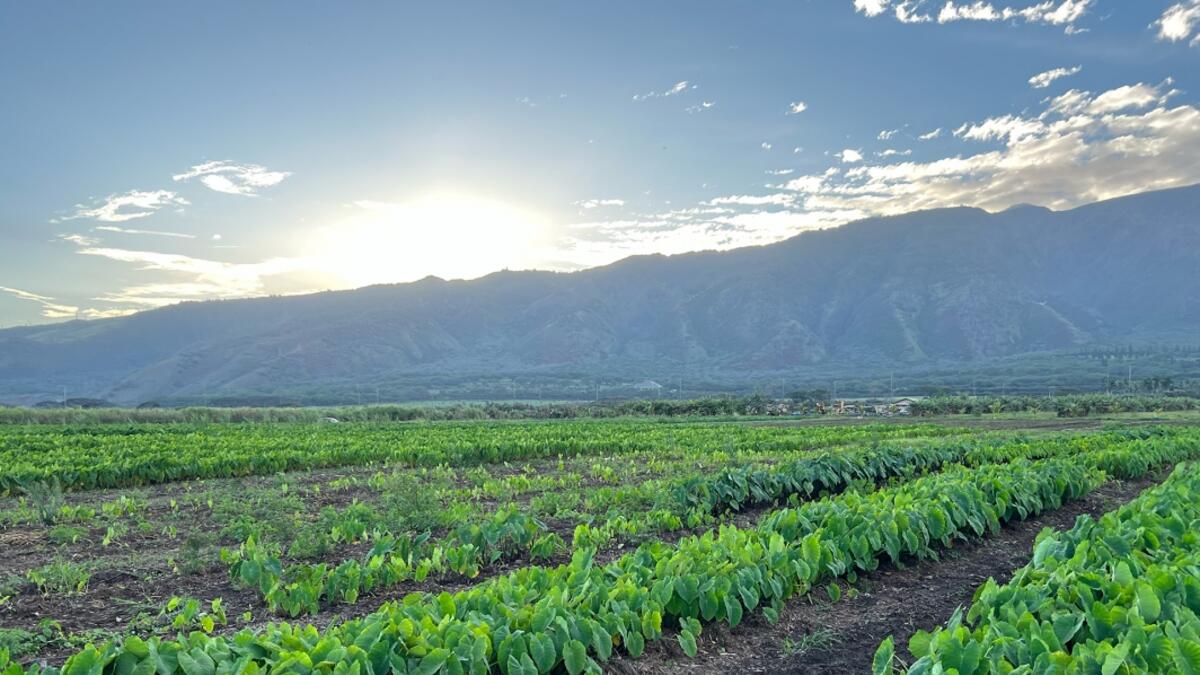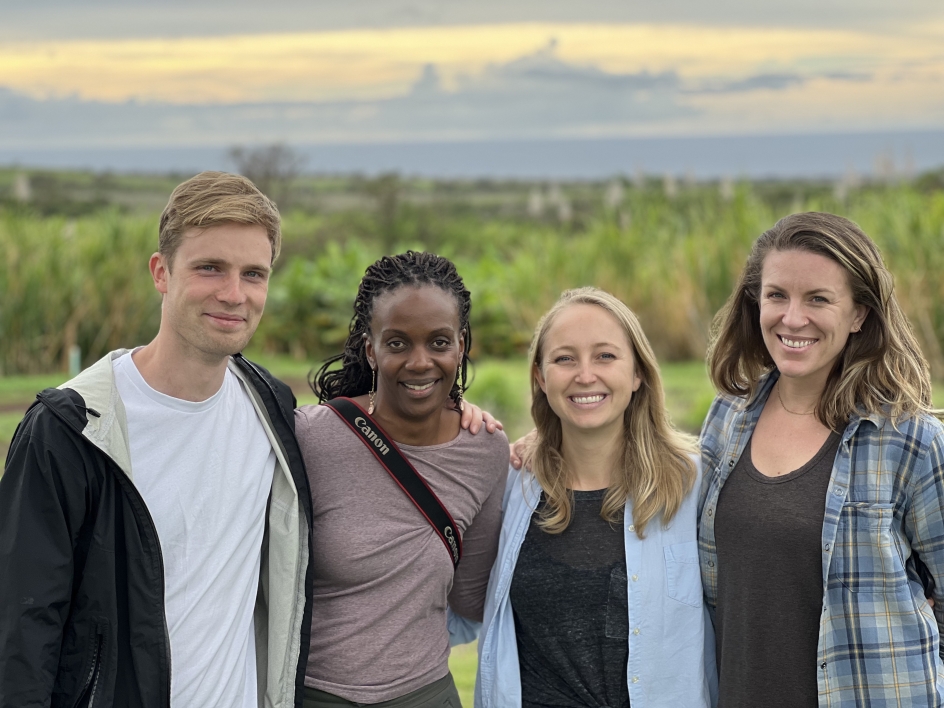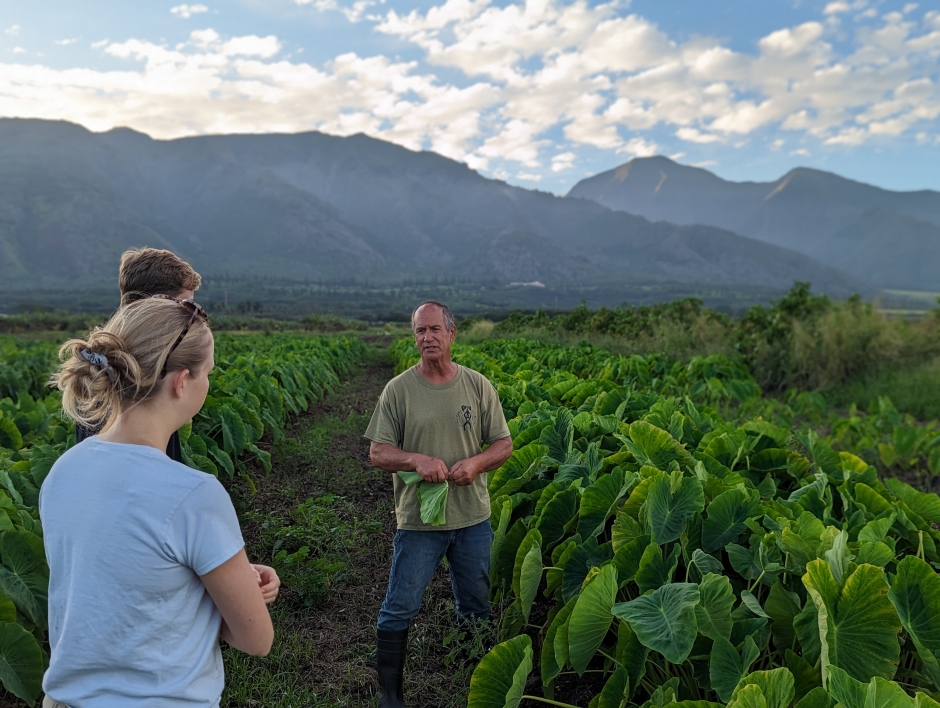Despite having a year-round growing season and rich, productive soil, Hawaii has the highest food costs in the U.S. and a strong reliance on imported foods.
“Maui County in particular is extremely vulnerable to systemic shocks like supply chain disruptions and climate change impacts,” says Hannah Kerner, an assistant professor of computer science in the School of Computing and Augmented Intelligence, part of the Ira A. Fulton Schools of Engineering at Arizona State University.
These steep food prices disproportionately affect lower-income residents and contribute to food insecurity in Hawaii. They also negatively impact small-scale, Indigenous farmers who have been historically marginalized in state and national policies and investments, stifling their production of native crops and consequently their livelihoods.
Kerner is addressing the issue in a project with NASA Harvest, NASA’s food security and agriculture program. Kerner is the U.S. domestic co-lead and artificial intelligence lead researcher for the program, which is housed at the University of Maryland Center for Global Agricultural Monitoring Research and operating as a consortium of international partners from more than 50 institutions around the world.
Kerner’s team is working with Maui United Way and other local partners to develop a food security dashboard that uses machine learning and satellite Earth observations to create new datasets for measuring and monitoring agricultural production across Maui County, which includes the Hawaiian Islands of Maui, Lanai and Molokai.
Machine learning, a branch of AI, uses data to train models to predict variables or future outcomes. Using local agriculture data and satellite Earth observations of Hawaii’s crops, Kerner’s machine learning models will be able to predict gaps in local food supply and access. This information will help Maui County decision-makers determine how to address food insecurity by identifying where crop growth can be more successful and assisting farmers with insights that will help them to grow more food locally, therefore decreasing Hawaii’s dependence on importing food.
In addition, the dashboard will integrate other relevant datasets like socioeconomic and price data to guide community decisions and actions, thereby empowering growers and decision-makers to combat food insecurity by helping to set fair prices for local growers and consumers.
“The dashboard will focus on supporting small-scale, independent and Indigenous farmers in Maui County and fill critical gaps in the knowledge of agricultural production at multiple scales across the county,” Kerner says. “It will also enable decision-makers and members of the Maui County community to continuously monitor the status and conditions of crops grown locally and develop policies and programs to boost production by small and indigenous farmers in a sustainable and culturally appropriate way.”
Engaging local communities in Maui County
Earlier this year, Kerner and her team visited Maui County to teach a training course and collect field data for the project with local students from University of Hawaii Maui College, or UHMC, one of NASA Harvest’s local partners, as well as high school students from across Maui County. The student program, called ʻĀina Data Stewards, is managed by Kerner’s team and UHMC.
“We’ve been very intentional with the way we’ve implemented this program to make sure it’s community-led, respectful and sensitive to existing dynamics,” Kerner says. “We are not collecting any data without farmers’ consent and we are engaging farmers and other community leaders throughout the process to ensure the project is co-developed and serves the community’s interests and needs.”
Kerner also notes that “there has been a huge effort with outreach, education, meeting partners and community members for Zoom meetings, visiting farms and really showing the community that we’re there to help them achieve what they want and not bring our own ideas while taking their data.”
During the trip, Kerner and her team trained approximately 30 UHMC and local high school students to collect data about local crops growing in Maui County, including foods like taro, bananas and coconut. Kerner’s team will combine the crop information with satellite data to create a machine learning model that makes more accurate and wider-ranging predictions about which crops are growing and where, giving farmers insight on current crop production and conditions.
Taro is a root vegetable and believed to be one of the world’s oldest cultivated crops. The root is used to make poi, a staple in Hawaiian cuisine. Photo courtesy Jacob Adler
Kerner’s collaborators in Hawaii say the team’s approach in involving the local community is key to the success of the dashboard and other tools to effectively combat food insecurity.
“This collaborative project is important because it will help to ensure that the ways the data are collected, analyzed and used will serve Maui Nui‘s needs and decision-making for the community’s collective benefit,” says Lui Hokoana, chancellor of UHMC.
“UHMC’s new Hulihia Center for Sustainable Systems provides a systems framework for the project, including training for the ʻĀina Data Stewards students,” Hokoana says. “The opportunity to bring together NASA Harvest’s cutting-edge technologies and our local stakeholders to design and implement community-based solutions for increasing local food production, including Native Hawaiian farmers, is a critical effort to achieve a sustainable future for Maui.”
NASA Harvest’s partnership with Maui United Way helps drive the project’s mission to have a community-led influence.
“The impacts of this research will have long-lasting effects on how our food systems adapt to various factors,” says Nicholas Winfrey, president and chief professional officer at Maui United Way. “We’ve already seen a variety of community input and insight on where this project should go. By allowing our community to guide this process, we’ve seen insights into the potential of where farms were years ago and the current impacts those practices are having on us now.”
Shay Chan Hodges, a collaborator and co-organizer of the Maui ESG Project, an initiative of Responsible Markets, is noticing the effects of this work.
“We see a lot of potential positive impacts from this partnership, which is already inspiring farmers and students,” she says. “During conversations with the NASA Harvest scientists, students and farmers have been excited about how access to satellite data can help them to understand numerous historical events and patterns, and predict and prepare for future events.”
Left to right: Incoming ASU doctoral student Ivan Zvonkov; Catherine Nakalembe, assistant professor at the University of Maryland and Africa program director with NASA Harvest; ASU Assistant Professor Hannah Kerner; and Alyssa Whitecraft, associate research professor at the University of Maryland, deputy director of NASA Harvest and director of NASA ACRES. Photo courtesy Jacob Adler
Additional U.S. and worldwide applications
NASA Harvest began in 2017 with a $15 million, five-year grant from NASA Headquarters. The first five years focused on advancing the use of satellite Earth observations for agriculture monitoring and food security in the U.S. and worldwide. The grant was renewed for another five years to continue and expand these efforts internationally.
Some of the NASA Harvest team members, led by Deputy Director Alyssa Whitcraft, were also recently awarded a new $15 million, five-year grant from NASA to implement a new consortium focused on U.S. agriculture. Kerner will also serve as the AI lead for this new consortium, which will be called A Climate Resilient Ecosystems Approach to Strengthening U.S. Agriculture, or ACRES.
“A lot of what we’re doing in NASA Harvest is very interconnected across the globe,” Kerner says. “For both NASA Harvest and ACRES, I coordinate the projects that involve AI, and the consortium’s priorities serve as real-world use cases that drive much of the AI research that my group at ASU does. We focus on developing new advances in AI research that are tied to real people’s needs, and then actually work to deploy them into practice around the world.”
Kerner’s agriculture mapping has also produced high-resolution, multiyear cropland and crop type maps for other countries, including Kenya, Rwanda, Malawi, Namibia and Tanzania.
According to Ivan Zvonkov, an incoming doctoral student to Kerner’s lab who has worked with NASA Harvest for two years, the agricultural maps are being used by stakeholders for downstream applications, including cultivated area estimation, crop yield forecasting and crop conditions assessments.
“Research in this field has the potential to contribute to solutions to many societal challenges,” says Zvonkov, who will be attending ASU in the fall. “This has motivated me to think more broadly about designing and building machine learning systems that empower people.”
Ivan Zvonkov and Hannah Kerner discuss crops with Uncle Bobby Pahia (center), owner and farmer at Hawaii Taro Farm LLC. Photo courtesy Alyssa Whitcraft
Funding sources for Kerner’s Maui County project with NASA Harvest include the NASA Equity and Environmental Justice Program, NASA Harvest and the NASA ACRES program.
Top photo: Assistant Professor Hannah Kerner and her research team recently visited Hawaii to record the locations of crops, like those growing in this field of taro. Photo courtesy Jacob Adler
More Science and technology

ASU student researchers get early, hands-on experience in engineering research
Using computer science to aid endangered species reintroduction, enhance software engineering education and improve semiconductor material performance are just some of the ways Arizona State…

ASU professor honored with prestigious award for being a cybersecurity trailblazer
At first, he thought it was a drill.On Sept. 11, 2001, Gail-Joon Ahn sat in a conference room in Fort Meade, Maryland. The cybersecurity researcher was part of a group that had been invited…

Training stellar students to secure semiconductors
In the wetlands of King’s Bay, Georgia, the sail of a nuclear-powered Trident II Submarine laden with sophisticated computer equipment juts out of the marshy waters. In a medical center, a cardiac…



